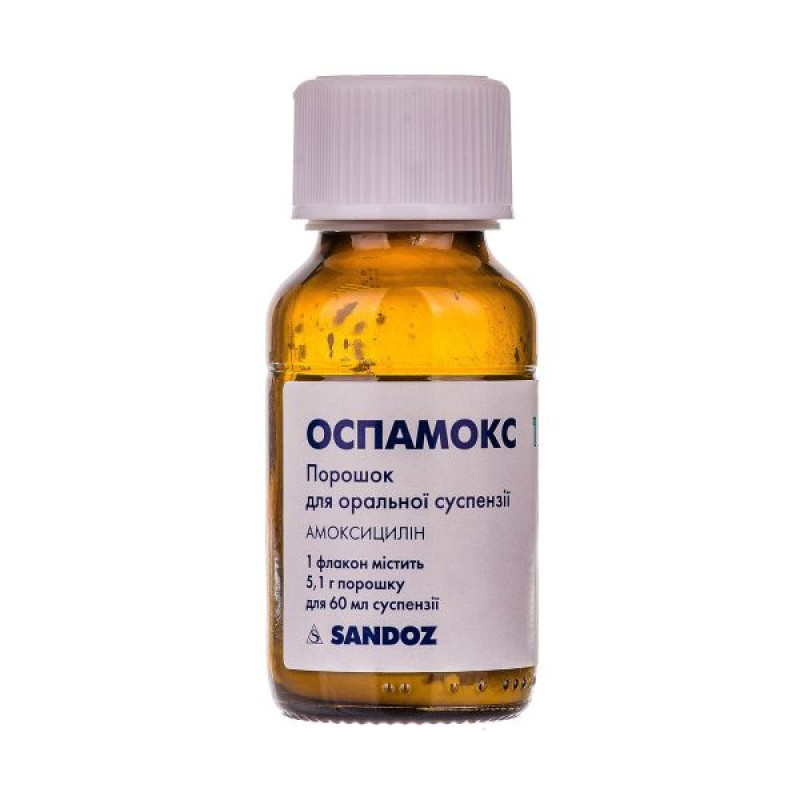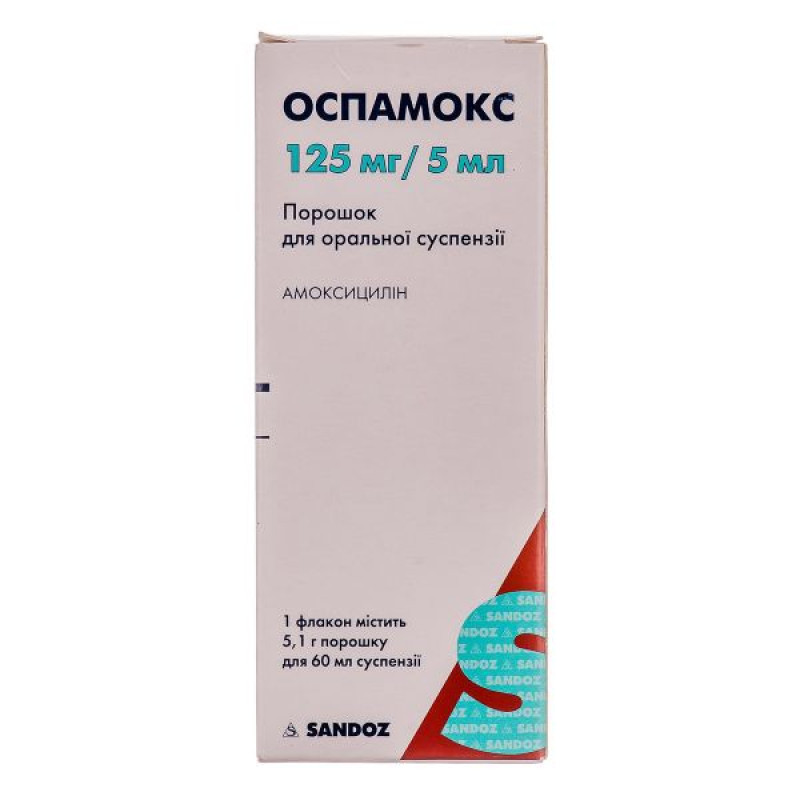Ospamox powder for oral suspension 125 mg/5 ml bottle 5.1 g 60 ml

Ospamox is indicated for the treatment of the following infections:
acute bacterial sinusitis; acute otitis media; acute streptococcal tonsillitis and pharyngitis; exacerbation of chronic bronchitis; community-acquired pneumonia; acute cystitis, asymptomatic bacteriuria during pregnancy; acute pyelonephritis; typhoid and paratyphoid fever; dental abscesses with widespread cellulitis; infections of prosthetic joints; eradication of Helicobacter pylori (as part of combination therapy); Lyme disease.The drug is used for the treatment and prevention of endocarditis.
Composition
active ingredient: amoxicillin;
5 ml of suspension contain 125 mg or 250 mg or 500 mg of amoxicillin in the form of amoxicillin trihydrate;
Excipients: citric acid, sodium benzoate (E 211), aspartame (E 951), talc, trisodium citrate anhydrous, guar gum, precipitated silicon dioxide, lemon flavoring powder, peach-apricot flavoring powder, orange flavoring powder.
Amoxicillin is a broad-spectrum bactericidal antibiotic from the group of semi-synthetic penicillins. It inhibits the synthesis of the bacterial cell wall. Amoxicillin is inactive against microorganisms that produce beta-lactamases. The level of resistance of sensitive microorganisms may vary depending on the region.
Contraindication
Hypersensitivity to amoxicillin, other penicillins or excipients of the drug. History of severe hypersensitivity reactions (including anaphylaxis) to beta-lactam antibiotics (including cephalosporins, carbapenems or monobactams).
Application features
Amoxicillin crosses the placental barrier; its concentration in the fetal plasma is approximately 25-30% of the concentration in the pregnant woman's plasma. Limited data on the use of amoxicillin during pregnancy indicate the absence of a negative effect on the fetus / newborn. Animal studies have shown the absence of a teratogenic effect of amoxicillin. If it is necessary to prescribe amoxicillin during pregnancy, a careful assessment of the ratio of the potential risk to the fetus and the expected benefit to the woman should be carried out.
Amoxicillin is excreted in small amounts in breast milk, so the risk of hypersensitivity in the child during breastfeeding cannot be excluded. The use of the drug during this period is possible only if the expected benefit to the mother outweighs the potential risk to the child. Breastfeeding should be discontinued if the newborn develops gastrointestinal disorders (diarrhea), candidiasis or skin rashes.
Fertility: There are no data on the effect of amoxicillin on fertility in humans. Animal reproductive toxicity studies have shown no effect on fertility.
Children
The drug is prescribed to children from birth. Children from 12 years of age can use other dosage forms of the drug - tablets; dispersible tablets.
Ability to influence reaction speed when driving vehicles or other mechanisms
Studies on the effects on the ability to drive and use machines have not been conducted. However, some adverse reactions (e.g. allergic reactions, dizziness, convulsions) may affect the ability to drive or use machines.
Method of administration and doses
The dose of amoxicillin is determined by the doctor depending on the age, body weight and kidney condition of the patient, as well as the sensitivity of microorganisms and the localization of the infectious process.
Preparation of suspension.
Shake the bottle to separate the powder from the walls and bottom. Add drinking water in two portions (first 2/3, and then up to the circular mark on the bottle in the form of a recess in the glass), shaking the bottle each time. Shake well before each intake.
To measure the suspension, a dosing syringe with an adapter or a 5 ml measuring spoon with 1.25 ml and 2.5 ml markings is included.
Method of application.
Food intake does not affect the absorption of amoxicillin. The finished suspension should be taken undiluted with water.
Overdose
Symptoms: digestive tract dysfunction - nausea, vomiting, diarrhea, which may result in a violation of water and electrolyte balance.
Cases of crystalluria have been reported, sometimes leading to renal failure.
Convulsions may occur in patients with impaired renal function or those who have received high doses of amoxicillin.
Treatment: induce vomiting or gastric lavage, then take activated charcoal and an osmotic laxative. Maintain water and electrolyte balance. Amoxicillin is removed from the blood by hemodialysis. No specific antidote is known.
Adverse reactions
The most common side effects are diarrhea, nausea, and rash.
Interaction with other medicinal products and other types of interactions
Probenecid, phenylbutazone, oxyphenbutazone, and to a lesser extent acetylsalicylic acid and sulfinpyrazone reduce the renal tubular secretion of amoxicillin, which may lead to an increase in its plasma levels and prolongation of action. Concomitant use with amoxicillin is not recommended.
Allopurinol. Concomitant use with amoxicillin may increase the likelihood of allergic skin reactions.
Tetracycline. Tetracycline and other drugs that have a bacteriostatic effect (macrolides, chloramphenicol) can neutralize the bactericidal effect of amoxicillin.
Store at a temperature not exceeding 25 °C in the original packaging.
Keep out of reach of children.
Use the prepared suspension within 14 days;
Store the prepared suspension in a refrigerator (2-8 °C).
Shelf life - 3 years.
There are no reviews for this product.
There are no reviews for this product, be the first to leave your review.
No questions about this product, be the first and ask your question.








